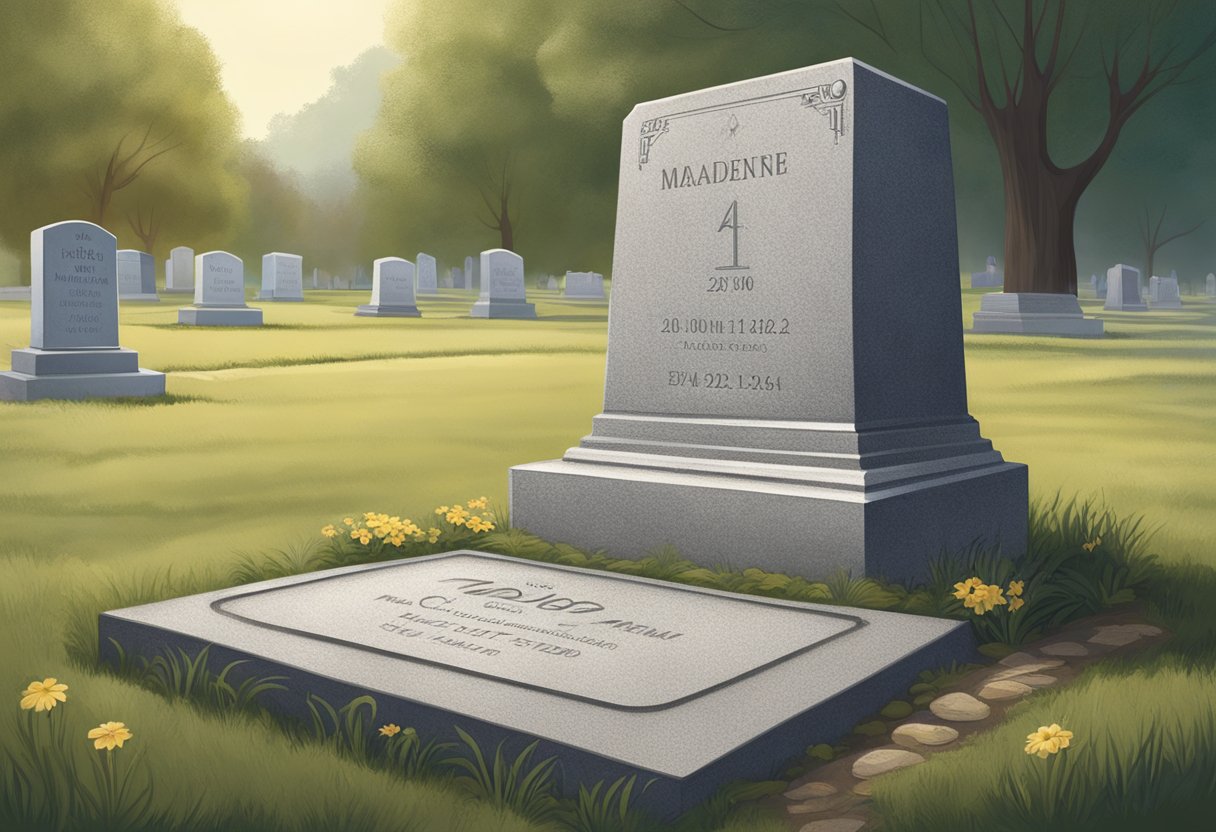Table of Contents
When taking a stroll through a cemetery, one can’t help but notice the variety of markers adorning the final resting places of the departed. The terms “headstone” and “tombstone” pop up frequently and seem to refer to those stone slabs standing on gravesites like silent sentinels.
But is there really a difference, or are the terms as interchangeable as socks in a teenager’s laundry pile?

Curiously enough, these markers didn’t just spring up from the ground; they have a storied history stretching back to ancient civilizations. The Greeks and Romans didn’t just throw epic parties; they left us with lasting legacies in memorialization practices too.
Fast forward to today, when one chooses a grave marker, design intricacies such as engravings, materials, and symbols come into play, each carrying weight in the grand scheme of commemorating the deceased.
Key Takeaways
- Headstones and tombstones, while often used interchangeably, carry their own slices of history and meaning.
- Magnificent marble or granite markers bear witness to evolving cultural practices in honoring those who’ve passed on.
- Selecting a fitting memorial involves understanding these nuances, echoing a truth as old as time—details matter, in life and in stone.
Historical Backdrop: From Greek Memorials to Modern Markers

In the chronicles of commemoration, one will find the Greek’s burying rituals giving birth to the concept of marking final resting places with stone slabs, later evolving into today’s grave markers.
Headstone Heritage
The term “headstone” originally comes from a Middle English term signifying a stone set at the head of a grave plot. Historically, they:
- Have been crafted from various stones and styles, suggesting social status
- Were only seen fit for the wealthy, leaving common folks to mark graves with mere fieldstones or nothing at all!
Tombstone Evolution
Behold the “tombstone,” derived from the Greek words “tymbos” (meaning burial mound) and “stia” (meaning pebble). One might say that:
- Ancient Greeks kicked off the trend with inscribed memorials.
- The term evokes a whiff of grandeur and a nod to its ancestry, with the word “tombstone” dating back to 1711 for marker uses.
Design Details: Carving Out the Differences

When one wanders through a cemetery, they’re often met with an array of meticulously crafted memorials. As we unearth the nuances between headstones and tombstones, it’s the design quirks that quite literally set them in stone.
Headstones Styles
Headstones are the fashionistas of the graveyard, flaunting a variety of styles that can range from the classically simple to the extravagantly ornate. They are typically upright slabs, showcasing:
- Style: Sleek and modern to vintage
- Material: Often marble or granite for that timeless look
- Carving: From straightforward names to intricate scenes
Here’s a taste of the usual array seen:
| Engraved | Symbols | Decorative Elements |
|---|---|---|
| Names and dates | Religious icons | Sculpted flowers and vines |
| Epitaphs | Social or military affiliations | Elegant borders |
Tombstones Textures
Now, tombstones – they’re the old souls with a penchant for the grandiose. They often cover the entire grave and are like a canvas for the deceased’s life story, boasting:
- Textures: Rugged, embossed surfaces that give a 3D pop
- Quality: Hardy materials ready to brave the elements
- Etchings: Detailed images and symbols that dig deep into the stone’s surface
They might tease the eyes with:
- Images: From cherubs hovering above to the dearly departed’s favorite pet
- Symbols: Everything under the sun, including the sun itself!
- Embossed Designs: Text that rises up, like it’s reaching out for one last high five
And, while they might not speak, these textural maestros sure know how to tell a tale without uttering a single word.
Cultural Context: Rituals, References, and Rock-Hard Riddles
When pondering the permanence of a person’s passing, it’s intriguing how societies celebrate the stone symbols that stand in sacred spaces, namely headstones and tombstones.
Ceremonial Significance
The customs surrounding these grave markers are as varied as they are venerable. Take, for instance, the uncovering of a headstone: a poignant point in posthumous proceedings often accompanied by memories, mirth, and memorial quotes. This ritualistic reveal, known as an “Unveiling”, doesn’t merely manifest the marker; it mingles the hereafter with the heartfelt – a final flourish in stone-crafted farewells.
Unveilings: Ceremonial gatherings to reveal the headstone and celebrate the passed soul’s legacy.
Memorial Quotes: Inscribed inscriptions inciting introspection – perhaps a psalm or proverb, or a playful poke at posterity.
Etiquette and Legacy
Etiquette in epitaphs? Indeed, it’s a thing. Even in the eternal estate, good manners matter. One doesn’t simply scribble a shopping list on a stone; rather, a respectful representation of the reposed is required. Legacy looms large in these lithic ledgers, letting lines linger long into the future.
Grave Marker Messages: The delicate dance between dignity and a dash of whimsy.
Ceremonial Stones: Custom crafted for each character, from stoic to spritely, a forever footprint.
In essence, these stone sentinels serve as the final, firm handshake between the living and the dearly departed, echoing etiquette and kinship through the corridors of time. They are a testament to life’s fleeting nature, a physical footnote in the annals of ancestry – and occasionally, cheekily reminding us that, like taxes, death and tombstones are a certainty, albeit the latter a tad less taxing.
Practical Perspectives: Plotting the Purchase

When one embarks on the solemn journey of purchasing a memorial marker, they often find themselves entangled in the nuances of such a profound choice. They must consider the cemetery environment, the longevity of the marker, and the intended message for future generations.
Shopping for Stone
One might think shopping for stone is as easy as picking pebbles on a beach, but oh contraire! It’s a strategic operation involving type, style, and a dash of legacy planning. Here’s a breezy guide:
- Material Matters: Marble’s elegant, but granite stands the test of time.
- Inscriptions Insist: What you carve will carry on. Choose wisely, lest you delight future archaeologists with accidental humor.
- Size Suggests: Will it be a modest marker or a monolith that shouts, “Here lies an unmistakable life!”?
Lasting Legacy Logistics
Finding the perfect resting spot for your dearly departed’s marker is like scoring that coveted parking space at the mall; it takes patience and strategy. Here are some gravely serious tips:
- Plotting the Plot: The burial plot’s size in the cemetery might just dictate whether you’re going grandiose or garden-variety.
- Bylaws and Bureaucracy: Each cemetery’s guidelines are as unique as the souls they host. Adhere to them lest you fancy a midnight re-do.
- End-of-Life Befriend-of-Life: Engage in end-of-life planning with a spot of humor to soften the blow. After all, a little laughter makes the legacy livelier.
- Ideas for Back of Headstone - May 19, 2024
- Is a Headstone a Funeral Expense? - May 19, 2024
- Is Headstone Cleaning Profitable? Scrubbing to Success in the Monument Maintenance Market - May 19, 2024


Leave a Reply